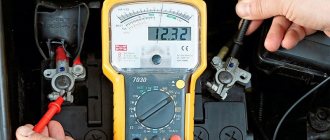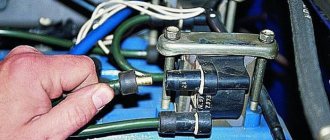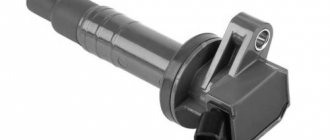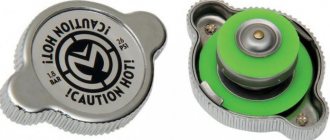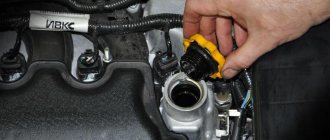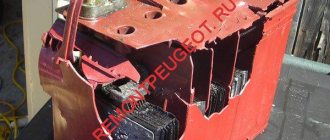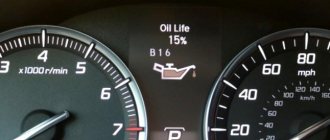The generator produces insufficient voltage. What to do?
Insufficient charge level of the car battery causes the engine to fail to start.
At night, insufficient voltage at the generator output can cause the engine to stop while driving. If the battery charging indicator light on the dashboard begins to blink or stays on while the engine is running, you should immediately measure the generator voltage supplied to charge the battery. You should also measure the voltage on the battery with the engine running. Causes of low voltage, methods of control and repair
The voltage supplied to the battery during operation of the power unit should be in the range from 13.2 to 15.0 Volts. If it is more than 15 Volts, the battery may be overcharged and the vehicle's electronic devices and additional devices may fail. If the voltage is less than 13 Volts, the battery is charged ineffectively; when powerful power consumers of the car are turned on, an extreme drop in the on-board network is possible. If less than 12 volts, the battery does not charge at all.
1. Weak belt tension.
Often this reason is accompanied by a belt drive whistling. It is also possible that lubricants and other liquids may come into contact with belt drive areas (pulleys, rollers). The belt should be cleaned using non-aggressive solvents. The belt also needs to be tightened. The level of “sagging” of the belt on a long free section when pressing on it with your thumb should be in the range from 0.5 to 1.0 centimeters. Over-tensioning is also dangerous: it leads to premature failure of rollers, bearings and bushings.
2. Failure of the “tablet” (chocolate) of the generator
. This is sometimes called a voltage regulator relay. Usually it cannot be repaired; it should be replaced with a similar one. In many cases, the regulator can be replaced without dismantling the generator.
3. Wear of generator brushes.
Sometimes they are included in the relay-regulator system and are replaced together with it. The remaining length of the brushes must be at least 7 millimeters; if less, they must be replaced.
4. Breakdown of rectifier diodes
. This malfunction occurs when the battery polarity is reversed. The generator becomes very hot when the engine is running. The diode “horseshoe” is changed completely or the diodes are replaced element by element.
5. Broken generator windings.
Inoperability can be determined by the different colors of the varnish insulation of the windings. In this case, the stator or rotor assembly is replaced. Rewinding windings is unprofitable.
Source
Poor voltage stabilization
If the voltage stabilizes in too large steps, and before everything was smooth, then the breakdown is close to the previous one - the switching device has failed at one or more adjustment stages. The algorithm for checking voltage stabilizer malfunctions and their elimination are described in the previous paragraph.
Attention! The characteristics of each stabilizer describe either the adjustment step or the boundaries of each stage, as well as the accuracy of maintaining the rated output voltage. In servo-drive stabilizers, this occurs when there is a breakdown in the engine gear mechanism, as well as when the windings are dirty, as was the case in the cases described above
Gearbox malfunctions may be accompanied by an uneven buzzing or crackling sound - this is the gears slipping
In servo-drive stabilizers, this occurs when there is a breakdown in the engine gear mechanism, as well as when the windings are dirty, as was the case in the cases described above. Gearbox malfunctions may be accompanied by an uneven buzzing or crackling sound - this is the gears slipping.
What to do: you need to disassemble the mechanism and if all parts are normal, replace the lubricant.
It is also worth noting that servo-driven MVs may lack stabilization and may not work correctly due to the failure of the semiconductor motor control switches. Then the slider with the brush moves to one of the extreme positions or does not move at all.
How much should the generator produce to properly charge the battery?
Constant undercharging of the battery or its absolute discharge at the most inopportune moment is a headache for many car owners. One source of these problems may be the generator. But how to check it? Perhaps it's not his fault at all? Let's figure out together how much the generator must produce for the normal functioning of all car systems and maintaining the battery in a charged state.
How to check the operation of the generator
The battery in a car is an important element of the system, which is responsible for providing the car’s on-board network with electricity. The generator is used to charge the battery while it is active. Unstable operation of a device generating electricity causes a voltage drop in the network and failure to restore the capacity of the power source.
Normal generator performance means timely and complete replenishment of the battery charge level, which decreases under load. Checking the battery charge level from the generator is simple and can be done by the car owner himself.
Diagnostics of an automotive energy-generating device includes a visual inspection of the unit, its elements and related parts, as well as voltage and current measurements. At least twice a year, you should check the tension of the drive belt, excessive weakening of which leads to a decrease in the performance of the generator, and sometimes can lead to breakdown of the device. Once a year, you can check equipment elements - fasteners, diode bridge, voltage regulator and others. Timely maintenance of the battery will also guarantee the absence of problems - cleaning the terminals, adding distilled water.
The principle of operation of the generator on the VAZ-2114
In order to convert one type of energy received from the engine into another, created by the generator, the presence of a magnetic field is necessary. And in order to create all the conditions for its appearance, the generator contains two main and very important elements - the rotor and the stator.
Generator rotor and stator
- The rotor in the generator is a movable element equipped with a steel core with tips. On these tips there are special coils for excitation, to which external power is supplied.
- The stator, in its design, is a ring, motionless according to the principle of operation, assembled from individual steel elements isolated from the winding. Inside the stator there is a winding made of fairly thick copper wire.
The above-mentioned elements of the generator are assembled together inside a metal case, in which along with them there are bearings that ensure proper rotation of the rotor, impellers, a pulley, a diode bridge, and a voltage regulator.
- The pulley is the direct drive of the unit, onto which the belt is placed, transmitting the energy of the engine.
- There are two bearings in the generator, front and rear. If the rear bearing fails, it can simply be replaced, which cannot be done with the front one, since it is pressed directly into the housing, and if it breaks, the entire part of the generator housing must be replaced.
The unit body has two removable parts, front and rear, which are fixed with bolts. The fixation is carried out in the same way for the stator, only it is already located on the inside of the housing.
Design of the VAZ-2114 generator
Features of operation
The generator on the VAZ-2114 is a fairly unpretentious device that can withstand heavy loads even in the most severe operating conditions, if all the rules for its operation are followed.
During its operation, the following basic rules must be observed:
- Do not allow the generator to operate when the battery terminals are disconnected. This is due to the fact that in the absence of a battery, there will be constant surges of electrical energy in the network, which can negatively affect all devices and the condition of the generator in particular.
- When carrying out welding work on a car, make sure that the wires are disconnected not only from the battery, but also from the generator.
- Make sure that all wires are connected according to polarity, because incorrect connection of wires, even for a short period of time, can render the entire system unusable.
- Checking the functionality of the generator should be carried out only in a strict order of work (indicated below).
Charging the battery at idle. Just something complicated
FOR BEGINNERS. Is the battery charging at idle
while driving, or is it generated only when the car is moving...
How to check the generator. what voltage does the generator produce?
AUTO REPAIR SITE my new channel...
What kind of charging should go to the battery from the generator?
It is traditionally believed that 13.5-14.5V should be supplied by the generator to the battery and this is absolutely enough to replenish the battery costs.
It is worth considering that using a battery with a higher power in a car than the manufacturer recommends also requires the installation of a more productive generating device.
It is necessary to take into account the load that the generator must withstand - it is calculated based on the maximum indicators of all electrical appliances and car systems.
Do not forget that the charging current from the energy-generating device will allow you to start the car in the cold season. In order to avoid problems with starting the car, we recommend purchasing generating equipment, the charge current of which will be approximately 10% of the capacity of the power source. That is, a battery of 100 A/h requires a generator that can produce 10A. Please note that for many cars, 100 amp equipment will operate at its maximum capacity, because the power consumption of the automotive system is in the region of 80 amps. Therefore, the choice of a source generating energy must take into account both the battery capacity and network consumption.
Battery overcharge
However, often it is not “undercharging” and “overcharging”. The electrolyte from the battery boils away and the battery also fails; there is nothing good about this either.
The first sign will be white streaks on the top of the battery, which means the electrolyte simply boils and evaporates. That is, the battery is charged, but the generator still “craps” charging it. The relay regulator has most likely failed here.
The check here is also elementary - you need to connect a multimeter or tester (whatever they call it) with the car running, and look at the charge. If it greatly exceeds 14.5 - 14.8 V, but is within the range of 15 - 15.2 V, it means that it is overcharging. We urgently change the relay-regulator, otherwise you will constantly boil your battery, ALSO NOTHING GOOD. It’s trivial that the plates may crumble.
Now let's watch the video version.
That’s all, he told me, exactly the methods without removing it from the car, and of course give it to a good auto electrician for repairs.
This is where I end, sincerely yours, AUTOBLOGGER.
(
89 votes, average: 4.45 out of 5)
Similar news
Engine chip tuning. Advantages and disadvantages. Is it worth doing at all? .
Generator overrunning clutch. What is it and what is it for? Important.
Why does the alternator belt whistle? When cold or under load. .
How to check the alternator voltage on the battery
The potential difference can be diagnosed in two ways - directly at the generating equipment and through the battery. The generator is directly connected to the power source with a thick wire, therefore, to check the level of potential difference, you can measure the voltage at the power source. To do this, you will need special devices - a voltmeter, multimeter or load plug.
The wires of the first measuring instruments are connected to the battery in any sequence. The plug must be connected to the battery terminals with strict observance of polarity. It is generally accepted that the normal voltage in the network should not be lower than 12 volts. At idle speed without turning on all the electrical appliances of the car, this indicator should be at the level of 13.5-14V. A drop in voltage values to 13.3-13.8 volts is considered acceptable.
At the same time, using conventional testing equipment, you can check the resistance of the generator elements - rotor, stator and diode bridge. Diagnostics of rotary equipment is carried out by its winding. It is necessary to connect the probes of the device with slip rings. If the multimeter gives readings from 2, 3 to 5.1 ohms, then this element is working. The current consumption of the winding should be within 3-4.5 amperes.
Its normal resistance is 0.2 Ohm. The diode bridge is checked by the presence or absence of resistance, the indicators do not matter. The only thing worth considering is that there should not be a zero dimension. Measurements are carried out in pairs - positive output and all plates on this side or minus and all elements.
We remind you that for normal charging of a car battery, the voltage supplied by the generator must be from 13.5 to 14 volts.
Generator check
The main sign of a malfunctioning energy source is interruptions in U (voltage). In this case, check the functionality of the system and figure out how much the car’s generator transmits to charge the battery.
When testing, follow the advice of experienced car owners:
check whether the fasteners are connected correctly;
check the quality of the belt tension;
valves should indicate a current of 12 Volts (V) and below;
When changing wiring, observe the cross-section diameter (the original and new ones ideally match).
If the element in question has received significant mechanical damage, we recommend entrusting its analysis to experienced auto repair shop employees.
How long should the generator charge? The algorithm for working with a multimeter looks like this: measure U at the battery terminals with the engine not running (the norm is 12.5-12.7 V). Start only the engine and repeat the measurement without load “at idle”. How many volts are supplied to excite the generator? “Healthy” indicators are from 13.8 V to 14.5 V (with a current strength of 80 to 140 Amperes).
How many amperes does a car alternator produce per battery?
The current strength required by the electrical system of each car is individual and depends on the number of electricity consumers and their values. And also the charge current must be sufficient to charge the power source.
It is worth noting that ampere readings appear only when there is a load in the vehicle’s electrical system and, accordingly, the battery is discharged. After starting the car engine, the charging current is about 6-10 amperes and drops over time, because the battery is charging, taking on the main energy consumption. If you turn on additional equipment - headlights, radio or heated mirrors, you can see an increase in the charging current values.
When purchasing a generator, pay attention to its technical characteristics, which the manufacturer indicates on the case - that’s where you will find information about the maximum current that will flow to the battery.
In the table below you can see the approximate current values that the generator shows at different loads.
Table 1. How many amperes the generator produces under load.
Design of a car generator
Any generator, with the exception of direct current models, creates multiphase alternating current - three or four phases, depending on the power. Why such a complication if the on-board network uses only direct current anyway? The fact is that a multiphase alternating current generator has higher efficiency, and most importantly, the current is removed not by brushes from the rotating rotor, but from the stationary stator windings. Accordingly, there are no problems with burnout of the collector (the current in it is much less than what the generator produces), and the collector itself is simpler - two rings, and not a set of insulated lamellas.
To convert polyphase alternating current into direct current, a diode bridge is used. At a minimum, it contains several powerful diodes with twice the number of phases - they are engaged in rectifying the current. Some generators also have additional diodes that provide power to the relay regulator.
The relay-regulator itself is no longer a relay: instead of an electromechanical device, electronic circuits are used to control generators, but the name “relay-regulator” has already firmly established itself behind it. They operate in the same way - by changing the current in the rotor winding (and the magnetic field in the core), they increase or decrease the voltage at the generator output so as to keep it within specified limits from 13.7 V (old low-power generators) to 14.5 V (modern generators designed for high power consumption of the on-board network and accelerated battery charging). Modern generators are no longer independent units, but are integrated with on-board controllers: the ECU controls the voltage, raising it after the engine starts to speed up battery charging, and then lowering it to normal.
The relay-regulator is powered from an external network (Zhiguli, most foreign cars) and from the generator itself through additional bridge diodes (front-wheel drive VAZs). The second circuit is considered less reliable, but has a distinctive ability to self-excite due to the residual magnetization of the rotor - the generator, spun up to high speeds, produces enough current for the relay-regulator to operate and bring it to operating mode.
Signs of a generator malfunction
In modern cars, breakdowns of the electrical system are one of the most common. A large number of electronics requires particularly careful monitoring of the operation and condition of the generator and battery, because their failure can immobilize the car. The most common signs of a generator malfunction are:
- battery indicator light on the instrument panel;
- unstable operation of the battery (its boiling over or undercharging);
- different intensity of headlights;
- extraneous sounds from the generator.
Generator malfunction identification and search for causes.
The main malfunctions of a car generator include:
- lack of battery charge,
- increased or decreased output voltage,
- destruction of bearings.
If the voltage is above 14.5V, the voltage regulator is most likely faulty. The contact of the negative terminal of the regulator with ground may also be broken. With a regulator installed outside the generator, there may be a voltage drop to the regulator (a typical malfunction for gazelles with a 402 engine). This may happen if the contacts in the circuit are broken. Therefore, the regulator will increase the generator voltage until the regulated value is reached.
Low voltage on the generator.
When troubleshooting, when the voltage is sufficient without load, and when the headlights are turned on, it drops below normal, first of all you need to pay attention to the tension of the drive belt. It is also worth paying attention to its position in the generator pulley, with the V-belt.
Weak tension or wear of the belt can be determined by sharply pressing the gas pedal, while the voltage drops sharply, and with further operation it can be restored. The belt tension is determined by pressing the belt with a force of approximately 8 kg, while the deflection should be 8 - 10 mm. With low tension, the belt slips, and with excessive tension, there is a large load on the bearings, which can cause their destruction. It is necessary to pay attention to the condition of the generator pulley with a poly V-belt. If the bottom of the pulley is shiny, the belt or pulley is very worn and needs to be replaced.
You also need to check the condition of the contact at terminal 30. If during operation of the generator this terminal becomes very hot as a result of poor contact, especially if there are traces of melting of the washer or nut, then it is necessary to clean and tighten the contact.
If the drive belt and the contact in the terminals are normal, then the generator is faulty. First of all, with such a malfunction of the generator, the diode of the rectifier bridge fails. It is also possible that the stator winding may break; the contact between the stator winding and the diode rectifier may be broken.
The generator does not produce current.
The absence of voltage supplied by the generator, that is, when the voltage at terminal 30 is equal to the battery voltage, is possible when:
- voltage regulator malfunction,
- breakage of the excitation winding,
- breakdown of the diode rectifier,
- lack of voltage on the excitation winding,
- jamming of rotor bearings,
- wear of slip rings,
- short circuit in the stator winding.
Other causes of low voltage
A small potential difference in the system is not always associated with a breakdown of the generator or a bad battery. If the diagnosis of these elements does not reveal any problems, then you should pay attention to the following:
- condition of the battery terminals - connection density and oxidation;
- electrical wiring problems - oxidation, violation of its integrity;
- output contacts to electrical appliances;
- correctly selected energy consumers.
Each contact must be tightly adjacent and intact, that is, there must be no formations (for example, sulfation) that will disrupt the flow of current. Incorrect connection of contacts leads to accelerated battery discharge even when the car is not running.
To improve the connection of the elements of the car's electrical system, it is necessary to clean all contacts and restore the integrity of the wires by replacing them or connecting them and wrapping them with insulating tape.
In conclusion, I would like to repeat that stable operation of the car requires constant monitoring of all elements, and the generator should attract special attention. The battery is charged from it and provides electricity to the entire car system. Pay attention to all elements: generator brushes, slip rings, voltage regulator, equipment winding.
The most correct measurements should be carried out when the battery is fully charged and in various modes. Remember that the manufacturer links the characteristics of the generator to the number of engine revolutions - they help produce a certain current.
Detailed video on how to check the generator:
Do you have experience diagnosing an alternator and solving problems in a vehicle's electrical system? Please share your experience and opinion with our readers in the comments. If you have questions about the topics covered, we will be happy to answer them.
Source
Checking the generator on cars with a ZMZ-402 engine
On cars with engines ZMZ-4025 and ZMZ-4026, generators 16.3701 or 191.3701 are installed, not equipped with a built-in voltage regulator. These generators operate in conjunction with an external transistor voltage regulator type 13.3702-01 or 50.3702, which has electronic protection against short circuits in the generator excitation winding circuit.
It is more convenient to do the work together.
We start the engine, let it run for a few minutes, then, pressing the gas pedal, bring the crankshaft speed to 3000 rpm. We turn on the consumers: high beam headlights; heater fan; wiper; emergency alarm. In this mode, we measure the voltage at the terminals of the battery, which should be above 12 V. If this is not the case, the generator windings are faulty (open or short), the voltage regulator with the brush assembly, the slip rings are oxidized or oiled, the brushes are worn out or “stuck.” In order to verify that the voltage regulator is faulty, turn off all consumers except the side lights and measure the voltage at speeds of 1000...1200 rpm, which should be within 13.8...14.5 V.
2. Connect a voltmeter or test lamp to terminal “W” of the block and the body of the voltage regulator. Turn on the ignition
If there is no voltage (the lamp does not light), one of the following malfunctions is possible: failure of contact of the excitation winding with the slip rings; break of the excitation winding; “hanging” of brushes in the channels of the brush holder; burning, oxidation and severe wear of the rotor contact rings.
How many volts should the generator produce?
For correct operation of the car, it is necessary to regularly check the functionality of the car generator. If this unit fails, the battery will no longer receive main power. This state of affairs (when the car is “powered” only by the battery) leads to a rapid loss of power to the entire car.
Timely monitoring of the technical condition of the electrical source will allow you to avoid accidental failure of the element, saving your money and mental strength.
The breakdown of the power unit generating current is determined by one of the following signs:
The light on the dashboard is constantly on (signal of insufficient current);
The battery constantly runs out;
electrical equipment malfunctions or does not work at all when the engine is turned on;
burning smell from the engine compartment;
The NODE makes uncharacteristic sounds (for example, rustling).
Don't waste your time - use the Uremont search and get offers from nearby services with specific prices!
Reasons for failure
If the symptoms described below appear, carry out diagnostics. You can do it yourself or take the car to a car service. To determine the cause of the failure, special equipment is needed. If you decide to figure it out yourself, master a multimeter tester.
Five possible sources of difficulty are described below:
bearing wedge (lubricant is used up, sometimes the belt breaks - you will need to replace or rebuild the unit);
the winding has burned out (a common cause is the reagents used to treat winter roads);
brush wedge (cause - wear of graphite cores);
the regulator relay is faulty (this element prevents the battery from overcharging and stabilizes the voltage);
The diode bridge is broken.
